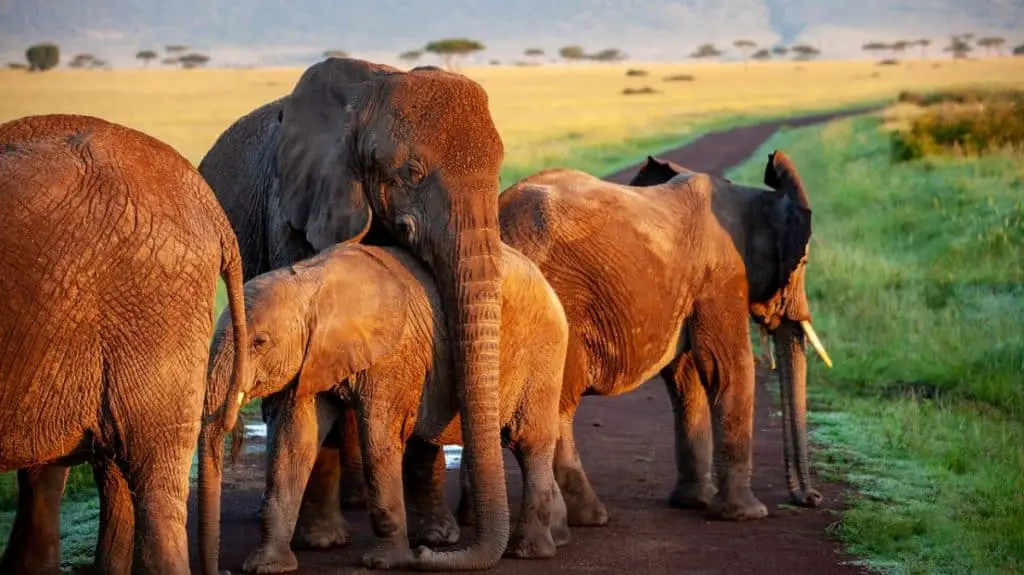Elephants have many ways of communicating, and scientists are still discovering new ways that they ‘talk’ to each other. Elephants are unique in some ways that they communicate, and this knowledge helps us understand them better.
Elephants use five main ways to communicate. These include visual communication through body language, over thirty different sounds, low-frequency infrasound, tactile touch, and pheromones.
Elephants send out two types of sound waves at once high-frequency sounds, such as the trumpet, which travels short distances, and low-frequency waves which travel much further through the earth.
Elephants eat a lot of different plants. Find out more here

Visually
Although elephants do not have the best eyesight, they still use visual communication to let others know the emotional state they are in. An elephant’s body language can show many different states, including threat displays, communicate intent, show frustration, or announcing their state.
An elephant that spreads its ears while lifting its head and trying to appear larger than they already are can be seen as a threat display. Bulls in musth walk differently from others and signal to other males to stay away. A dominant male can walk in a specific direction to get others to follow them, while a subordinate male can show frustration by shaking their head or throwing sticks.
Musth in elephants can make them very aggressive. Find out what it is here.
Through audio
With vocal cords eight times the size of ours, elephants use many vocal sounds to communicate with others. These are sophisticated, complex ways of conveying information over short and long distances.
Elephants use sounds ranging from loud trumpets to infrasonic calls, too low for humans to hear. Elephants use about 30 calls to speak to others. These include different calls used to warn others of danger or to coordinate movements of the herd. Elephant herds can become dispersed over large areas, so they can be used to bring them all together again.
Elephants can recognize other family members by their calls and other bond members from elephants from other herds. Females can identify over 100 different elephants just from their calls.
Elephants have excellent hearing and will react to others at distances up to 4 km away, although, in the right conditions, this can increase up to 10 km.
The distance that sound can travel depends on the time of the day. Lower frequencies travel further in cooler weather, and elephants make many of their calls before sunrise and after sunset.
Elephants can recognize individuals up to 2.5 km away. An elephant call can be as loud as 117 decibels, which is like most large rock concerts.
Most sounds that elephants make are infrasonic and are in frequencies below what humans can hear. When recordings of these were made in a zoo in the 1980s and then played back, it was found that the elephants were making as much noise as a herd of cows in a field. These lower frequencies can be heard over greater distances.
You can tell if an elephant is listening as it will raise its head and ears and freeze in place.
Do you know which animals can take down an elephant? Find out here in this article I wrote.
The most common sound that we associate with elephants is the trumpeting sound. This is produced by forcing air through the trunk. This sound is either used to warn intruders or as an alarm. It is also used when playing when they approach a waterhole or meet up with other elephants.
A frustrated or annoyed elephant can produce a growling or roaring sound. This is created with the head lifted, and the mouth open and many calves make this noise when they are trying to suckle.
Elephants also chirp, which signifies that they are either alarmed, excited, or agitated. Chirps are usually made in sequences of two to eight sounds.
Panic in young elephants, such as being chased by a predator, can make them scream. This high-pitched noise is rarely heard in adults.
Elephants produce a lower rumbling sound than a human can hear. However, other elephants can listen to this sound up to 4 km away.
The Arabian oryx is a master of survival. Find out how these magnificent animals survive here.
Seismic communication
To communicate over long distances, elephants can pick up seismic waves which travel through the ground. They can pick up the sound of animals running or charging. These sounds travel up to distances over 30 km and are picked up through the feet. Elephants have been known to notice thunderstorms up to 300 km. When there is a stormy day during the dry season, the behaviour of elephants changes; elephants will travel longer distances when they hear a rainstorm instead of their usual short-distance foraging.
An elephant’s heavily padded feet contain a ball of fat called the digital cushion, which spreads out, and dozens of receptors called Pacinian corpuscles pick up the vibrations and send a signal to the brain. The ground vibrations also travel through the skeleton up to the ear.
In an experiment by Caitlin O’Connell-Rodwell in Namibia, it was noted that an alarm call played through a speaker and then through an underground geophone elicited a different response from the elephants. With the sound playing through the air, the elephants immediately left the area.
However, when the sound was played through the ground, the vibrations made the elephants stay for a while before leaving. This is because the elephants thought the danger was further away when they could hear the sound through the earth.
Elephants use their trunks in lots of different ways. Find out more in this article I wrote
Being tactile
Elephants are very tactile regarding family bonding, especially between adults and their calves. Elephants use many parts of their body to touch each other, including their trunks, head, ears, body, and tails.
Whenever an elephant touches another elephant, it is to communicate and not simply due to them being clumsy. Who the elephants stand next to indicates whether they like them.
Elephants use their trunks to communicate with each other, and studies show this. When elephants wrap their trunks around one another, they greet each other and show the other that they want to play.
Play between elephants can get out of hand pretty quickly, especially between males, so placing their trunk into another’s mouth shows that they are subordinate.
Trunks are also used in discipline, with the calves being slapped, shoved, or pulled by the adult’s trunk. However, the trunk is also used to reassure their young, as are the tail and the foot.
Do you know why hippos spend so much time in the water? Find out here

Using chemicals to communicate
Elephants use pheromones to communicate information over short and long distances. Elephants have an excellent sense of smell. The pheromones contain information such as the physical and emotional states of others, their presence, and even where they have been.
Elephants can recognize others by their smell and can often be seen using their trunk to touch another elephant’s genitals, mouth, and ears. They will also use their trunks to get information from dung and urine. This gives them information about reproduction status, physical state, and health. Urine is full of data on the reproduction status of females in oestrous and serves to attract males. Bulls that have musth will rub secretions against vegetation
Elephants can often be seen with their trunks held in the air and moving around to smell the air. Elephants can smell danger from predators or other elephants over long distances.

